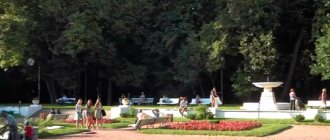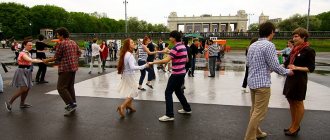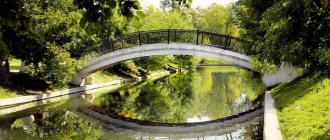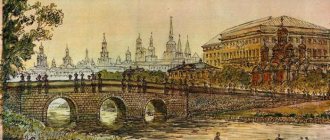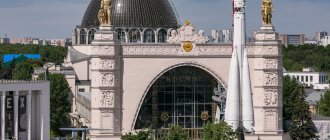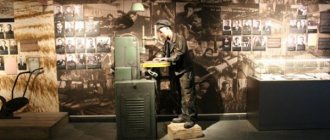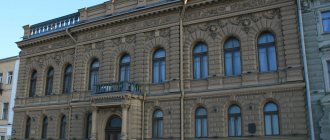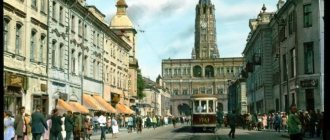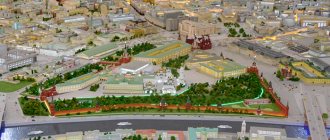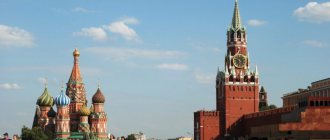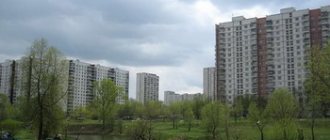Pogodinskaya is a rather long but very quiet street, suitable for leisurely walks. There are very few residential buildings, cafes and restaurants on it due to the schools, universities, research institutes and hospitals located around it, but there is a real wooden hut. Igor Abyzov and Anna Naumova have compiled a guide to their favorite Khamovnikov street.
In the warm season, there is a lot of shade on the street from trees and tall buildings of university hospitals. The roadway is narrow, so there are not many cars on Pogodinskaya, and here you can take a break from the noise of the neighboring Bolshaya Pirogovskaya Street. It is useless to look for Pogodinskaya on old maps - it did not exist until the 1890s. Previously, old houses simply stood on the border of the Maiden Field. After this land was given to Moscow University to create a clinical campus, Pogodinskaya Street began to appear.
Now it runs parallel to the Moskva River embankment and Bolshaya Pirogovskaya Street. Between Pogodinskaya and Pirogovka there are buildings of Sechenov University. We will begin our journey along Pogodinskaya from Novodevichy Proezd, and end with exit to the 2nd Truzhenikov Lane.
If you turn from Novodevichy Proezd onto Pogodinskaya Street, the first buildings will be residential buildings. After them, on the right side, up to Abrikosovsky Lane, stretches the huge building of the University Hospital No. 1. Opposite is a city estate of the late 18th - early 19th centuries, consisting of several buildings with pylons and a fence. This is the main house of the Ganeshins Factory-Estate. The entire ensemble is a cultural heritage site.
Photo: Wikimedia.org
House of the Ganeshins Factory-Estate
In the 17th-18th centuries, this territory contained rich country estates, which were later passed on to manufacturers, who set up large enterprises in them. The complex of buildings at Pogodinskaya 18, 20, 22 was no exception. The houses have retained their original appearance: the façade is decorated with pilasters and sandstones, and the central building has a small mezzanine. The Ganeshins themselves were large Moscow manufacturers, and the current Maly Savvinsky Lane was at one time called Ganeshinsky.
We cross Abrikosovsky Lane (it received its name only in 1955 in honor of academician Alexei Ivanovich Abrikosov, who worked in university clinics; the bust of Abrikosov is located not far from Pogodinskaya Street in front of the building of the 1st Medical Institute). On the left side is the Iraqi Embassy, and after it we will see the main attraction of Pogodinskaya Street - the Pogodinskaya Izba.
Photo: Fotokto.ru
How Gogol cooked Italian pasta in the Pogodinskaya hut
Photo: Shutterstock
Photo: Shutterstock
Photo: Shutterstock
A small wooden house painted sky blue on Devichye Pole in Khamovniki is the legendary Pogodinskaya Izba. In her early youth, 150 years ago, she managed perfectly well without “makeup,” maintaining the natural color of her “face.” Only the friezes on the second floor were coquettishly painted with floral patterns.
The elongated upward proportions of the building are uncharacteristic of a classic Russian log house, and the lace carved patterns on the facade, platbands and shutters are pseudo-Russian, a “collective image”, so to speak. And after the Great Patriotic War, the entire frame had to be assembled: in 1941, it was hit by a fascist air bomb. The original appearance was restored only by 1972, and today the Pogodinskaya Izba is all that remains of the estate of the famous historian, friend of Pushkin and Gogol, academician and professor of Moscow University Mikhail Pogodin. By the way, the street on which the “lanky” hut stands is also Pogodinskaya.
When the historian collected a collection of unique ancient Russian artifacts and a rich library - the “Ancient Depository” - the estate on Devichye Pole became a place of attraction for the best writers of that time. 17-year-old Afanasy Fet studied at the Pogodinskaya School, and Lermontov, Ostrovsky, Zagoskin, Baratynsky, Shchepkin, Vyazemsky, Aksakov often attended literary evenings here...
And Gogol completely “registered” in the hut: after the warm climate of Italy, the writer still could not get used to the “cold” Moscow summer, and therefore he was specially placed in a bedroom on the sunny side of the mezzanine. While working on the first volume of Dead Souls and Taras Bulba, Gogol spent hours studying ancient documents in the owner’s “Ancient Vault”.
When the writer had a creative crisis, he went down to the large master’s hall, where the whole family gathered in the evenings, and began to “think” - he quickly walked from corner to corner, raising strong “vortex” gusts and drinking a glass of water every 10 minutes. Pogodin’s elderly mother was very unnerved by this habit of Gogol, and she shouted to the maid: “Pear, and Grusha, give me a warm scarf, otherwise the Talian (that’s what she called the famous guest) has let in so much wind, it’s such passion!” To which Nikolai Vasilyevich good-naturedly replied: “Don’t be angry, old man, I’ll finish the second decanter and that’s it.”
It is interesting that the footman in Pogodin’s house was called Lyapkin-Tyapkin, and the writer immortalized the appearance and habits of his friend and hospitable owner of the estate in the image of Plyushkin, which is why they subsequently quarreled to smithereens.
When Gogol was in a good mood (for example, he got enough sleep or celebrated his name day), he surprised the Pogodin family or his friends-writers who were visiting the historian-philanthropist with his culinary abilities. But for lunch, the author of “Viy”, “The Night Before Christmas” and “Evenings on a Farm near Dikanka” did not prepare Ukrainian borscht at all, but his signature “author’s” dish - his favorite Italian-style pasta.
Nikolai Vasilyevich did not allow anyone to participate in the process of the mystery of turning Russian noodles into Italian “Parmigiano pasta”. And at the same time he behaved like a real chef: he cooked spaghetti in a large bowl and skillfully sorted through each pasta, after which he generously added butter, grated cheese and mixed thoroughly. The presentation of the dish was no less theatrical: with a cheerful smile, opening the lid of the pan in front of his compatriots who opened their mouths, Gogol looked around at everyone sitting at the table and exclaimed: “Well, now - lean in!” True, sometimes the cook, like a writer, went too far with the pepper, and many people thought that the pasta was undercooked... And then Nikolai Vasilyevich began to explain what it is - “al dente”...
And the writer’s friends also remembered his “family” cooking - eggnog. True, the writer’s recipe was far from traditional: it contained no eggs, no bread, no honey - only goat’s milk brewed in a special way with the addition of rum. In general, the writer lived in the Pogodinskaya hut, drinking heavily, and often, laughing, said: “Gogol loves gogol-mogol!”
st. Pogodinskaya, 12A
View on map
Pogodinskaya hut
Pogodinskaya Izba is one of the oldest surviving wooden buildings in Moscow. The hut was built in 1865 by the architect Nikolai Vasilyevich Nikitin and presented to the historian Mikhail Petrovich Pogodin. It became one of the first archives in Russia and was used to store historical relics. This is a striking work of Russian wooden architecture. The hut is decorated with elements traditional for wooden crafts - valances, towels and carved platbands.
Almost at the very end of the street stands the recently built residential complex “Life on Plyushchikha” in the neo-Stalinist Empire style. Until recently, in its place there was a monument of constructivism - the Pogodinskaya Workers' Village.
Photo: Wikimapia.org
Wooden houses inside the Moscow Ring Road
Long-lived wooden houses are held on with all their strength so that Muscovites can see with their own eyes what the city was like. Photographer Kirill Lebedev has been photographing buildings that may disappear from the map of Moscow for several years. Of particular value are the houses that survived the fire of 1812.
— The wooden houses of Moscow have long attracted my attention, and not at all with the banal slogan “a tree in the concrete jungle,” but with the special comfort that is unique to them. One of the goals of the project is to find all the wooden houses inside the Moscow Ring Road, says Kirill Lebedev.
The photographer studied in the Novoslobodskaya area, where he first photographed several residential wooden houses. I saw how the owner destroyed a house in 2nd Vysheslavtsev Lane with a chainsaw. Then he began to “hunt” for all existing wooden buildings in Moscow.
At the end of 2021, a house on Malaya Semenovskaya Street that belonged to the merchant Fedot Makarov, which was built at the beginning of the twentieth century, was demolished. The green wooden house had carvings and beautiful platbands - details can now only be seen in the photo of Kirill Lebedev.
The log house on Verkhnyaya Maslovka, which was built in 1913, has been trying to be placed under state protection for several years. But the future fate of Izba na Maslovka still causes serious concern. It is probably the last surviving wooden dacha in Petrovsky Park. There are only Soviet buildings nearby.
“The house on Maslovka was not denied protection status on its merits, but the applications for protection themselves were rejected three times “in form,” says Moscow expert Yulia Dmitryukova.
Local residents and tour guides even remember the large faceted dome in the right corner of the roof. Apparently, it was lost in a fire in the 70s and 80s. For the last twenty years, there has been a “Crafts Center” here, where they held classes in ceramics and pottery, local history lectures, and you could drink tea in a cafe. The building is now closed and not in use. If the owner has a desire to demolish the “Izba”, then nothing can prevent it. Only Moscow risks losing a rare example of pre-revolutionary wooden construction.
Will all of wooden Moscow gradually disappear and remain only in photographs?
- It's not all that bad. Architectural monuments will be protected by the state. And other wooden buildings, which are also not inferior in their beauty and style, may gradually leave Moscow. “But I would like to preserve this beauty,” says photographer Kirill Lebedev.
Work settlement "Pogodinskaya"
The demolition of the village, purchased by the developer back in 2000, began in 2021. The constructivist quarter consisted of six five-story apartment buildings: symmetrically aligned, with cut corners and protruding loggias. The village was built in 1926-1929 for factory workers, and residential buildings created a single ensemble with a recreation center.
Opposite the current elite residential complex there is a small temple of the Archangel Michael at the clinics on Devichye Pole.
Photo: Yandex
Pogodinskaya hut. History of waste
November 11 - 205 years since the birth of the famous Russian historian Mikhail Petrovich POGODINA
In Moscow, not far from the Novodevichy Convent, there is Pogodinskaya Street, named after Mikhail Petrovich Pogodin, a professor at Moscow University, historian, publicist, one of the most enlightened people of the 19th century. He lived here, on Devichye Pole, in his own estate, which has not survived to this day. On the territory of the estate there remains the famous “Ancient Depository” - “Pogodinskaya Izba”.
And today, on the red line of the left even side of the street, there is this two-story wooden house, which seems to move forward, showing off among the stone buildings. The house is covered with a gable roof, decorated with wooden carved lace, its windows have patterned frames, and there is a light in the mezzanine. Built by architect N.V. Nikitin in 1856 built the hut according to all the rules of Russian wooden architecture and was an original gift from the major Russian businessman Kokorev to his highly respected historian, connoisseur and collector of Russian antiquities.
Pogodin was friends with many outstanding people of his time. In this “Pogodinskaya hut” on Devichye Pole, Slavophiles often gathered - Samarin, Khomyakov, Aksakov... Pogodin, who kept a detailed diary throughout his long life, described his meetings with Pushkin and Lermontov; Gogol lived in his house for several years. Actor Shchepkin visited him, playwright A. Ostrovsky read his plays here, and Leo Tolstoy came here to consult with Pogodin while working on the novel “War and Peace.”
“There is not a single old or young native inhabitant in Moscow who would not know on the Devichye Pole a long shady garden, a Russian hut and a house under a green roof, who would not say that this is the residence of Mikhail Petrovich Pogodin,” said on the half-century anniversary of the professor’s scientific work, Moscow mayor A.P. Lyapin in 1872.
How many people know about this “settled life” today? Do they remember Pogodin himself, whose 200th anniversary five years ago went unnoticed?
The magazine with the wonderful name “Moskvityanin”, whose editor for many years was Mikhail Petrovich Pogodin, who came from the family of a serf manager, has not been published for a long time. In the middle of the 19th century, a unique phenomenon of Russian culture arose in the magazine - the “young editorial staff”. “Elder Michael” gave the actual editing to young writers Apollo Grigoriev and Alexander Ostrovsky. The magazine became the mouthpiece of true nationality and the soil, Moscow trend in literature.
The spacious and green Maiden Field no longer exists. The shady garden near the house has also disappeared, but the famous “Russian hut” still stands. Unfortunately, this is all that remains of the estate, the main mansion of which, bought by Pogodin from Prince Shcherbatov, was destroyed in 1941 during a Nazi air raid. In 1972, the original appearance of the hut was recreated. The restoration was carried out with funds from the All-Russian Society for the Protection of Historical and Cultural Monuments. The regional branch of VOOPIiK of Moscow is located in the Pogodinskaya hut. Before the rampant reforms and privatization, Muscovites came to this house to listen to an interesting lecture or the sounds of an ancient piano. Then the hut stood for several years under lock and key, gradually collapsing. Nowadays it has taken on a fairly decent appearance, but has lost its cultural purpose: Spetsstroymonolit LLC has settled in the historical hut. I found his website on the Internet to find out what the new owners were doing. I discovered that the company builds ordinary houses in Moscow and the Moscow region.
Perhaps such a utilitarian use of a cultural and historical monument is better than complete desolation, but still: why are we so wasteful? Why can’t we use our beauty and antiquity, the echo of our legends and memories to instill in our children love for the Motherland? By the way, Pogodin’s area of interest was the ancient history of Rus' and the Slavs. He collected a large collection of written and material monuments of Russian history. The “Ancient Storage” had 17 sections. The first consisted of manuscripts (included about 2 thousand monuments), the second - 800 early printed books, the third consisted of books printed under Peter I, etc. The artistic part of the collection included paintings, icons (about 2000), extensive collections of graphics (popular prints, portraits of Russian figures, early examples of Russian engravings). In 1852, most of the collections were acquired by the treasury for the Public Library and the Hermitage, and church antiquities entered the Armory Chamber. Where is all this stored now, in what storage rooms? What a wonderful exhibition of Moscow antiquities could be created in the Pogodinskaya Izba! What excursions on Moscow studies to conduct for schoolchildren and guests of the capital!
But there is no prophet in his own country, and there is no limit or justification for our wastefulness...
Church of the Archangel Michael at the clinics on Devichye Pole
The five-tent temple was built in 1894–1897. With the consecration of the temple, the construction of the clinical campus was completed. The temple was conceived as a house church for all the clinics in Devichye Pole, but residents of nearby streets also began to come there. During Soviet times, the temple was used as a pharmacy, gym, warehouse and institute museum. Then the medical institute wanted to completely demolish the temple for the sake of building a catering unit, but through the efforts of active residents of the area and architects, the demolition was stopped. In the early 90s, the temple was returned to the Russian Orthodox Church, and church life there resumed.
Pogodinskaya street ends at the club.
Club
The Kauchuk cultural center is a project by architect Konstantin Melnikov, a world-famous monument of Soviet avant-garde architecture. The cultural center is located at the intersection of Plyushchikha Street and 2nd Truzhenikov Lane. The club resembles a rotating mechanism and has a sector shape. Inside there is a semicircular, three-tier auditorium that can accommodate up to 800 people.
Many architects used the sectoral shape of buildings to design the corner of a block, placing the sharp part of the building at the intersection of streets. Melnikov approached this problem in a more interesting way: on the corner he placed a semicircular part of the building, and the pointed end goes into the courtyards. The cylinder facing the street houses a small cash register lobby and the main entrance. The cylinder is surrounded by two staircases - a unique system designed by Melnikov, with the help of which it was possible to easily access different parts of the building.
According to Melnikov’s design, a gym was attached to the right side of the club’s façade, which was used for its intended purpose for quite a long time. You can read about the fate of the monument in the new Russia in the MOX material.
Text: Igor Abyzov and Anna Naumova
